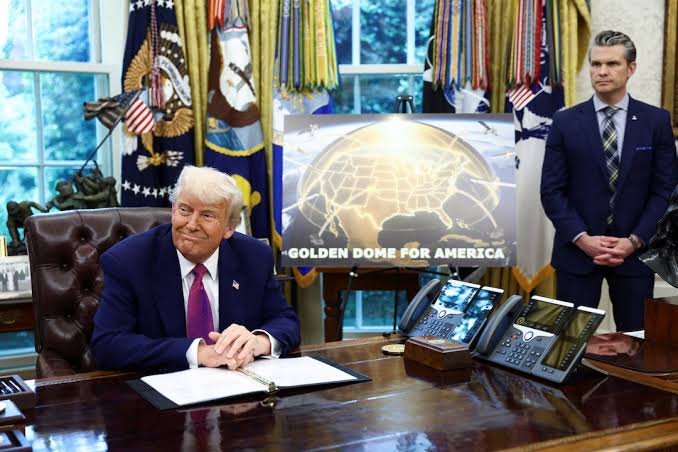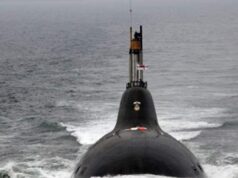With Golden Dome missile shield USA to turn space into the next battlefield

The US Space Force was founded on 20 December 2019 as the 5th Armed Forces of USA. Now Donald Trump has wasted no time reviving one of the most ambitious and controversial military initiatives in US history. Within weeks of inauguration, Trump signed an executive order launching the “Golden Dome,” a sweeping missile defense shield designed to “ protect” the United States from ballistic and hypersonic threats through a complex web of land, sea, air, and – most significantly – space-based systems.
Touted as a bold leap into the future, the Golden Dome initiative is being derided as Ronald Reagan’s 1983 Strategic Defense Initiative, the “Star Wars.” At that time the vision, was technologically unfeasible.
However it laid the concept for a space-based shield against enemy projectiles. Now, Trump argues, the dream is finally feasible, thanks to decades of advancements in sensor arrays, satellite-based tracking systems, and missile interceptor technologies.
At a press conference flanked by Defense Secretary Pete Hegseth and US Space Force Vice Chair Gen. Michael A. Guetlein, Trump declared the Golden Dome “the crown jewel of American defense.” He claimed the system would be operational by the end of his term in 2029, with layered defense capabilities capable of intercepting missiles from across the globe or launched from space itself.
The architecture of the Golden Dome will integrate a multi-domain system – land-based radars, naval interceptors, airborne command modules, and satellite constellations – forming what officials describe as an “omni-directional shield.” Trump’s vision also includes strategic collaboration with Canada, seen as critical in covering the vast northern approach to the US mainland.
The Golden Dome has triggered alarms across the geopolitical spectrum. Critics from scientists and legal scholars to diplomats and arms control advocates warn that the project represents a tectonic shift in international security, one that risks undermining decades of space demilitarization agreements and re-igniting a perilous arms race in orbit.
The primary legal controversy centers on the 1967 Outer Space Treaty, the cornerstone of international space law. This treaty bans the placement of nuclear weapons or other weapons of mass destruction in space but leaves a critical loophole by not explicitly prohibiting conventional weapons. Trump’s Golden Dome intends to exploit this omission by deploying non-nuclear kinetic interceptors in orbit.
China, viewing the initiative as a destabilizing escalation, issued a strong condemnation. A spokesperson for the Foreign Ministry warned that the US risked turning space into a “war zone,” undermining the principle of peaceful use of outer space. Beijing called on Washington to reverse the decision and engage in multilateral talks to prevent the militarization of space.
Russia’s reaction was more nuanced. Kremlin spokesman Dmitry Peskov said “We are entering an era where space and nuclear issues must be discussed in the same breath” suggesting that Moscow may be willing to return to the negotiating table – but on its own terms.
India has not reacted so far but will surely enhance its own capabilities as demonstrated by recent Operation Sindoor against Pakistan.
The timing of Trump’s announcement is striking. Nearly every major arms control treaty from the Cold War era has either collapsed or is in suspension. The Anti-Ballistic Missile (ABM) Treaty is long dead. The Intermediate-Range Nuclear Forces (INF) Treaty was terminated in 2019. And the New START treaty, the last remaining bilateral nuclear agreement between the US and Russia, is set to expire in 2026. India and China, meanwhile, have never participated in any major arms control pact.
Without these guardrails, the introduction of space-based interceptors further erodes the fragile balance of strategic deterrence. Analysts warn that other powers may now feel compelled to develop similar systems or increase their offensive capabilities to overwhelm American defenses. This “security dilemma” – where defensive moves by one state provoke countermeasures from others – could rapidly spiral into a new era of militarized rivalry.
Even within the United States, the initiative is stirring intense controversy. With an initial $25 billion allocated in the 2025 defense budget, and long-term costs estimated between $161 billion and $540 billion over 20 years, the Golden Dome represents one of the most expensive defense projects in US history.
Democrats in Congress have already mobilized opposition. Senator Elizabeth Warren, joined by 42 Democratic lawmakers, has called for an investigation into defense contracts tied to the program. Concerns center on transparency, oversight, and potential profiteering. Elon Musk’s company SpaceX, a major defense contractor, has been singled out for allegedly benefiting from non-competitive awards and political favoritism.
The Congressional Budget Office has also flagged the program’s ballooning costs and uncertain outcomes, noting that “past attempts at space-based missile defense have suffered from both technical and financial shortfalls.” Experts from the American Physical Society have reiterated the enormous challenge of “hitting a bullet with a bullet,” especially at hypersonic speeds and in the harsh conditions of space.
By anchoring its defense posture in space, Washington signals that it no longer views conflict solely through terrestrial lenses. Instead, it is preparing for 21st-century warfare in multi-domain battlefields, where space, cyber, and AI-integrated systems will play decisive roles.
Perhaps the most fundamental question raised by the Golden Dome is this: what kind of future do we want for space? The idea of space as a neutral, cooperative domain is enshrined in international law and inspired by decades of scientific collaboration, such as the International Space Station. Turning it into a battleground could mark a point of no return.
Diplomats at the United Nations are scrambling to revive arms control efforts. Yet recent failures underscore how difficult consensus is. In 2024, a US-Japan draft resolution to ban WMDs in space was blocked by Russia and China for not including conventional weapons – highlighting the deep mistrust now defining global diplomacy.
Golden Dome is a grand bet – on technology and on deterrence. But it’s also a high-stakes gamble that could backfire spectacularly. By launching a missile defense system in space, Trump may indeed fulfill Reagan’s vision – but at the cost of global strategic stability. During cold war USA had to contend with only the Soviet Union. However now Russia, China and India the other poles of Power too will get in the race and have the capability to beat the USA in this game. Even Japan and European Union will notsut idle.
If space becomes the next battleground, it will not be because it was inevitable. It will be because world powers chose conflict over cooperation. The US must now decide: will the Golden Dome be a shield for peace, or the spark that ignites the next arms race in the stars?
The final frontier, once the realm of astronauts and scientists, is rapidly becoming the domain of generals and defense contractors. The future of space – and of international security – may well depend on whether the world can rein in its most destructive instincts, before the weapons go orbital.




